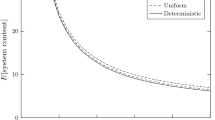Abstract
We analyze the time-dependent behavior of various types of infinite-server queueing systems, where, within each system we consider, jobs interact with one another in ways that induce batch departures from the system. One example of such a queue was introduced in the recent paper of Frolkova and Mandjes (Stochastic Models, 2019) in order to model a type of one-sided communication between two users in the Bitcoin network: here we show that a time-dependent version of the distributional Little’s law can be used to study the time-dependent behavior of this model, as well as a related model where blocks are communicated to a user at a rate that is allowed to vary with time. We also show that the time-dependent behavior of analogous infinite-server queueing systems with batch arrivals and exponentially distributed services can be analyzed just as thoroughly.
Similar content being viewed by others
References
Abate, J., Whitt, W.: Numerical inversion of Laplace transforms of probability distributions. ORSA J. Comput. 7, 36–43 (1995)
Asmussen, S.: Applied Probability and Queues. Springer, New York (2003)
Baccelli, F., Brémaud, P.: Elements of Queueing Theory: Palm-Martingale Calculus and Stochastic Recurrences. Springer, New York (2003)
Bertsimas, D., Mourtzinou, G.: Transient laws of nonstationary queueing systems and their applications. Queueing Syst. 25, 115–155 (1997)
Bowden, R., Keeler, H.P., Krzesinski, A.E., Taylor, P.G.: Block arrivals in the Bitcoin blockchain. Preprint accessible through the arXiv at (2018). https://arxiv.org/abs/1801.07447
Brémaud, P.: Characteristics of queueing systems observed at events and the connection between stochastic intensity and Palm probability. Queueing Syst. 5, 99–111 (1989)
Brémaud, P.: Markov Chains: Gibbs Fields, Monte Carlo Simulation, and Queues. Springer, New York (1999)
Brockwell, P., Gani, J., Resnick, S.: Birth, immigration, and catastrophe processes. Adv. Appl. Probab. 14, 709–731 (1982)
Den Iseger, P.: Numerical transform inversion using Gaussian quadrature. Probab. Eng. Inform. Sci. 20, 1–44 (2006)
Eick, S.G., Massey, W.A., Whitt, W.: The physics of the \(\text{ M }_{t}/\text{ G }/\infty \) queue. Oper. Res. 41, 731–742 (1993)
Eyal, I., Sirer, E.G.: Majority is not enough: Bitcoin mining is vulnerable. In: Financial Cryptography and Data Security, pp. 436–434. Springer, Berlin (2013)
Fralix, B., van Leeuwaarden, J., Boxma, O.: Factorization identities for a general class of reflected processes. J. Appl. Probab. 50, 632–653 (2013)
Fralix, B., Riaño, G.: A new look at transient versions of Little’s law, with applications to M/G/1 preemptive Last-Come-First-Served queues. J. Appl. Probab. 47, 459–473 (2010)
Franco, P.: Understanding Bitcoin: Cryptography, Engineering, and Economics. Wiley, Chichester (2015)
Frolkova, M., Mandjes, M.: A Bitcoin-inspired infinite-server model with a random fluid limit. Stoch. Models 35, 1–32 (2019)
Göbel, J., Keeler, H.P., Krzesinski, A.E., Taylor, P.G.: Bitcoin blockchain dynamics: the selfish-mine strategy in the presence of propagation delay. Perform. Eval. 104, 23–41 (2016)
Huberman, G., Leshno, J.D., Moallemi, C.: An economic analysis of the Bitcoin payment system. Draft accessible at (2019). https://moallemi.com/ciamac/papers/bitcoin-2017.pdf
Javier, K., Fralix, B.: A further study of some Markovian Bitcoin models from Göbel et al. Submitted for publication: a draft is available at http://bfralix.people.clemson.edu/preprints.htm (2019)
Kallenberg, O.: Random Measures, 3rd edn. Akademie-Verlag, Berlin (1983)
Kasahara, S., Kawahara, J.: Effect of Bitcoin fee on transaction-confirmation process. J. Ind. Manag. Organ. 15, 365–386 (2019)
Kawase, Y., Kasahara, S.: Transaction-confirmation time for Bitcoin: a queueing analytical approach to blockchain mechanism. Queueing Theory Netw. Appl. LNCS 10591, 75–88 (2017)
Koops, D.: Predicting the confirmation time of Bitcoin transactions. Preprint accessible on arXiv at (2018). https://arxiv.org/abs/1809.10596
Latouche, G., Ramaswami, V.: Introduction to Matrix-Analytic Methods in Stochastic Modeling. ASA-SIAM Publications, Philadelphia (1999)
Li, Q., Ma, J., Chang, Y.: Blockchain queue theory. Preprint accessible on arXiv at (2018). https://arxiv.org/abs/1808.01795
Li, Q., Ma, J., Chang, Y., Ma, F., Yu, H.: Markov processes in blockchain systems. Preprint accessible on arXiv at (2019). https://arxiv.org/abs/1904.03598
Nakamoto, S.: Bitcoin: a peer-to-peer electronic cash system. Paper available at (2008). https://bitcoin.org/bitcoin.pdf
Ricci, S., Ferreira, E., Menasche, D.S., Ziviani, A., Souza, J.E., Vieira, A.B.: Learning blockchain delays: a queueing theory approach. ACM Sigmetrics Perform. Eval. Rev. 46, 122–125 (2018)
Tschorsch, F., Scheuermann, B.: Bitcoin and beyond: a technical survey on decentralized digital currencies. IEEE Commun. Surv. Tutor. 18, 2084–2123 (2016)
Wolff, R.W.: Poisson arrivals see time averages. Oper. Res. 30, 223–231 (1982)
Acknowledgements
The author would like to thank an anonymous referee for providing many useful comments on a previous draft of this manuscript.
Author information
Authors and Affiliations
Corresponding author
Additional information
Publisher's Note
Springer Nature remains neutral with regard to jurisdictional claims in published maps and institutional affiliations.
Appendix
Appendix
This section contains a slight rephrasing of Propositions 4.1 and 4.2 on page 17 of [15]. Throughout this appendix, we assume \(\{X_{n}\}_{n \ge 1}\) is a sequence of i.i.d. nonnegative random variables having a finite, positive mean, and we set \(\lambda := 1/\mathbb {E}[X_{1}]\). From these random variables, we define the partial sums \(\{S_{n}\}_{n \ge 1}\) as
Proposition 4.1
As \(n \rightarrow \infty \),
with probability one.
Proof
This result can be proven through an application of the classical Strong Law of Large Numbers: we omit the details. \(\square \)
Proposition 4.2
Let \(\{X_{n}\}_{n \ge 1}\) be a sequence of i.i.d random variables having finite mean, and fix two real numbers x, y satisfying \(0< y < x\). Then, by setting \(\rho := \lambda /\mu \), and letting \(\mu \downarrow 0\) (\(\lambda \) stays fixed) we find that
as \(\rho \rightarrow \infty \). Furthermore,
as \(\rho \rightarrow \infty \).
Proof
First, note that for any two integers m, n satisfying \(1 \le m \le n\), we have
Using both the classical Strong Law of Large Numbers, as well as Proposition 4.1, we find
which proves that
as \(n \rightarrow \infty \), thus proving (36). Finally, observe that statement (37) can be established with the same type of argument. \(\square \)
Rights and permissions
About this article
Cite this article
Fralix, B. On classes of Bitcoin-inspired infinite-server queueing systems. Queueing Syst 95, 29–52 (2020). https://doi.org/10.1007/s11134-019-09643-w
Received:
Revised:
Published:
Issue Date:
DOI: https://doi.org/10.1007/s11134-019-09643-w




